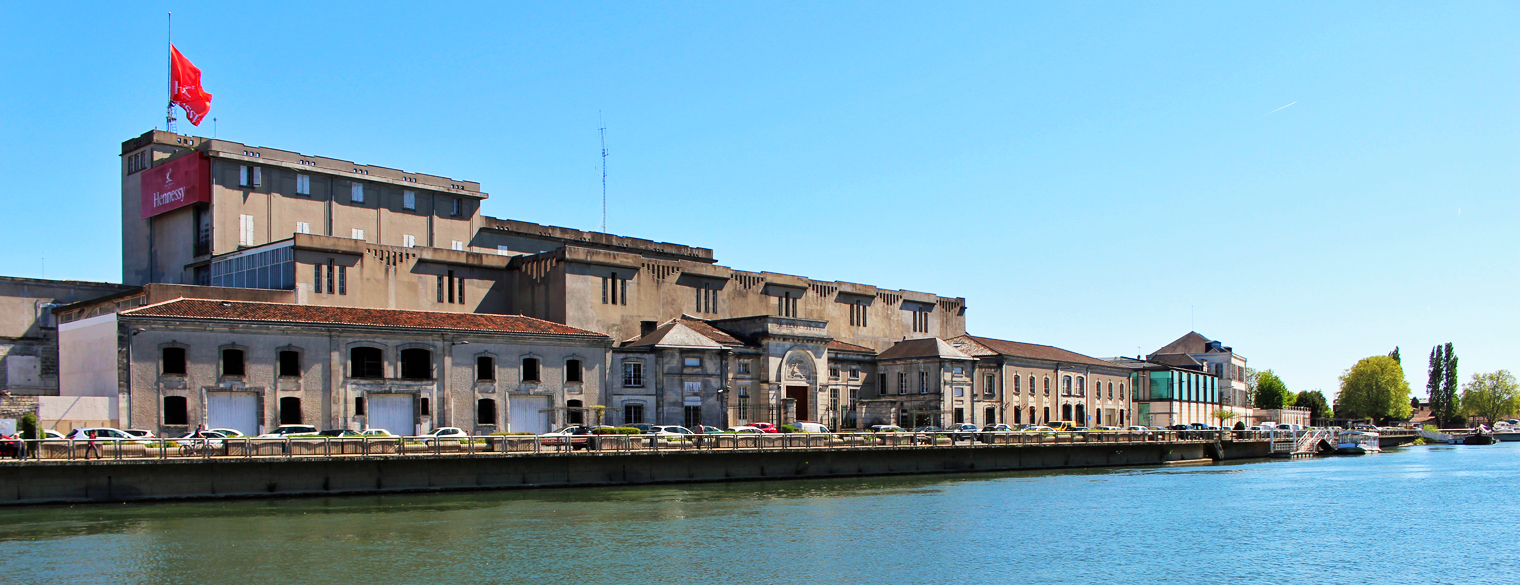___
City of Cognac – complete guide to explore
___
Looking for a destination that is both original and authentic for your next getaway? Passionate about heritage, culture and local flavours? Then the city of Cognac, nestled in the heart of the Charente in Nouvelle-Aquitaine, is for you.
A city of art and history, Cognac gave birth to King François I and shines internationally thanks to its famous eau-de-vie. It is also a friendly place, perfect for strolling along the Charente, marvelling at its centuries-old houses and Romanesque churches or immersing yourself in a rich cultural and sporting life. This comprehensive guide invites you to explore Cognac in all its facets: from its fascinating history and vibrant culture, to its famous Cognac houses, walking routes and tasty cuisine.
Join us for an unforgettable exploration and tasting of Cognac!
Discover Cognac: a journey through its history and culture
Located in the heart of France, Cognac is a city rich in history and culture, famous for its exceptionally well-preserved and valued heritage. Discover the many facets of Cognac below.
The history of Cognac and its heritage
With a history dating back to prehistoric times, attested by the Séchebec dolmen, Cognac has crossed the eras, from the Gallo-Roman period to the Merovingian and Carolingian reigns. It was the scene of struggles between France and England, before seeing the birth of King François I in 1494, in the castle of the same name, now the headquarters of the Baron Otard Cognac House.
Cognac has also distinguished itself by the development of wine brandy, which became the famous cognac, thanks to the distillation technique introduced by the Dutch in the sixteenth century. Today, the town is renowned for its many cognac trading and production houses, and is home to a museum dedicated to the precious beverage.
The must-see monuments of Cognac
The architectural heritage of Cognac bears witness to its rich past and culture. Sites to visit include:
- The church of Saint-Léger, a jewel of Romanesque art from the twelfth century, classified as a historical monument, contains frescoes, stained glass windows and an exceptional organ.
- The Porte Saint-Jacques, a vestige of the old fortifications of the fifteenth century, listed as a historical monument, and the entry point to the Old Port, the historic and lively heart of the city.
- The town hall, housed in the former 17th-century convent of the Recollets, also listed as a historical monument, and whose wedding hall and public garden are not lacking in charm.
- The Saint-Léger priory, founded in the eleventh century and now a contemporary art centre, is a place for artists’ residencies and various exhibitions.
- The Hotel Verdelin, a sumptuous eighteenth-century building classified as a historical monument, which houses the Cognac Museum of Art and History, exhibiting a rich collection on local history, cognac, decorative arts and fine arts.
Cultural events not to be missed
Cognac comes alive all year round with festivals and cultural events:
- Cognac Blues Passions, an international music festival held every summer in the Jardin Public and on the banks of the Charente.
- The Cognac Festival, an event that honors cognac and local gastronomy on the quays, with concerts and tastings.
- The Cognac Crime Festival, an autumn event for lovers of detective literature, bringing together authors, publishers and booksellers.
- Coup de Chauffe, a live performance festival that energizes the streets and squares of the city with its original artistic proposals.
- Festi’Classique, a classical music festival offering concerts in regional heritage sites, with recognized artists and new talents.
This introduction offers you an overview of the treasures of Cognac, a city of tradition, history and cultural vitality. For more information and to organise your stay, visit the Cognac tourist office website. Other festivals await you in Saintes or Royan, for example.
Enjoy your stay in Cognac!
The Cognac Houses: at the heart of the tasting
Discover the art of tasting at Cognac distilleries and trading houses, which reveal the mysteries of making and aging this legendary spirit. Learn to appreciate its unique aromas and flavors.
Take advantage of these tips for total immersion.
Visiting the distilleries and trading houses
In Cognac, an impressive variety of producers awaits you, from great historic houses to authentic family vineyards. Each place offers a unique experience, tinged with history and personality.
Explore famous houses such as Hennessy, Martell, Rémy Martin, and Courvoisier, offering discovery tours, cellar tours, workshops, and initiations. Discover the secrets of exceptional cognacs, from blending to ageing, and follow their international influence. Don’t miss the Château de Cognac, the birthplace of King François I, now the seat of the House of Baron Otard.
Or, choose a more intimate tour of a distillery or winery, where generations come and go to maintain unique craftsmanship. Observe the stills, cellars, and oak barrels, and awaken your senses by tasting cognacs of various vintages, ages and qualities.
To discover in particular: Bache Gabrielsen, Distillerie Tessendier, Cognac Chollet, Giboin, Domaine Drouet, Les Trésors du Château Montifaud and Cognac Fougerat.
Understanding the Cognac Making Process
A luxury product, cognac is subject to strict standards from the Bureau National Interprofessionnel du Cognac (BNIC) through several key stages:
- The harvest in September, where grape varieties such as Ugni Blanc, Colombard, and Folle Blanche are harvested.
- The vinification, transforming the must into white wine in just five days, without additions.
- The double distillation of Charente in copper stills, resulting in a 70% vol.
- Ageing in French oak barrels, providing colour, tannins and aromas for a minimum of two years.
- Reduction and blending, adjusting the alcohol content and mixing various eaux-de-vie for complexity and harmony.
- Bottling and labeling under AOC Cognac, ensuring quality and origin, with crucial details indicated on the label.
Tastings and initiations: tips for a rich experience
For a successful tasting, engage all your senses and your memory. Here’s how:
- Use a tulip glass to better capture the aromas.
- Look at the color and viscosity to judge the quality and aging.
- Smell without touching to distinguish olfactory notes, then aerate and smell again for more subtlety.
- Taste slowly, savor on the tongue and palate, and note the length in the mouth revealing complexity and character.
- Vary the cognacs by age and strength, write down your impressions and preferences.
- Experiment with sweet or savory sides, neat, with water, ice cubes, or in cocktails.
With these turnkey keys, you are ready for a memorable adventure in the heart of the Cognac Houses. Live the experience to the fullest!
Walks and gastronomy in Cognac
Exploring Cognac at the pace of your steps, by bike or by sailing on the water, you will be charmed by its rich heritage, its green panoramas and its vineyards. This city invites you to savor its rich gastronomy and specialties, celebrating the terroir and its famous cognac.
Find out how to fully appreciate Cognac.
The must-see walks in and around the city
Whether in the city or on its outskirts, Cognac offers a multitude of itineraries adapted to all desires. Highlights include:
- The Old Cognac circuit, for an immersion in the historical soul of the city, highlighting gems such as the Château de Cognac, the Saint-Léger church and the Saint-Jacques gate. The lively streets and squares, embellished with shops and restaurants, promise charming strolls.
- A walk along the Charente offers splendid views of the river and its banks. Crossing quays, footbridges and bridges, you will discover the river heritage through trading houses and washhouses. A river cruise reveals the hidden charms of the region.
- Explore the vineyards and surrounding countryside through hikes, discovering the fauna, flora and winemaking traditions of Cognac. Visits to distilleries and cognac tastings will punctuate this authentic experience, and may lead you to the Charente Maritime, on the banks of the Gironde estuary.
Gastronomy and local specialties
Cognac, a land of indulgence, offers a culinary immersion in the richness of its local products: Charentais melon, truffle, caviar, foie gras, goat’s cheese and honey. Traditional dishes, such as eel boiling or stew stew, invite you on a unique taste journey.
Local pastries, such as the galette charentaise or the millas charentais, as well as the cognac or pineau des Charentes, perfect as a side dish, offer a complete experience of regional flavors.
Pairing cognac and gastronomy: pairing tips
Cognac, versatile, goes perfectly from aperitif to dessert. Select it according to its age, its vintage and its aromas to brilliantly complement the textures and flavors of your dishes.
- For the aperitif, a VS or VSOP cognac, light and fresh, goes wonderfully with tapas, charcuterie and dried fruit. They are also excellent in cocktails, such as in the Cognac Summit, a refreshing blend of cognac, lime, ginger and soda.
- Choose an XO or older cognac for main courses, ideally paired with red meats, game, cheeses or chocolates. You can also use it to enrich your sauces by deglazing or flambéing.
- A vintage or collector’s cognac will be perfect for dessert, paired with fruit, creams, ice creams or cakes. It is also the perfect choice for a digestif, elegantly concluding your meal.
With these suggestions, Cognac is waiting for you for a memorable experience between cultural discoveries and gastronomic pleasures.
Conclusion
If you are looking for an authentic experience, immerse yourself in the world of Cognac, the undisputed capital of brandy. This city stands out for its incredible historical, cultural and gastronomic heritage. You will have the opportunity to admire exceptional architectural monuments, stroll along the peaceful banks of the Charente, visit emblematic distilleries and trading houses, savor the famous cognac accompanied by exquisite dishes, and immerse yourself in various cultural events.
The charming city of Cognac will captivate you with its warm atmosphere and unique way of life. Don’t wait any longer, plan your getaway to Cognac now.
Visit the official website of the tourist office to discover even more details about this fascinating destination and to access the most advantageous offers. We wish you a wonderful stay in Cognac!
FAQ
Where is the city of Cognac?
Located in the Charente department, in the heart of Nouvelle-Aquitaine, Cognac rests peacefully on the banks of the Charente, nestled between Angoulême and Saintes.
Why visit Cognac?
Visiting Cognac means discovering a city with a rich historical and cultural heritage, with gems such as the Château de Cognac, the House of the Lieutenancy and the Museum of Cognac Arts. Famous for its world-renowned brandy, Cognac invites you to explore the great cognac houses such as Rémy Martin, Martell, or Hennessy, offering an unforgettable taste experience. The city also seduces with its enchanting natural setting, with the Charente river which allows for pretty trips by barge or by bike.
Where to go for a walk in Cognac?
In Cognac, walks can be adapted to your tastes: from the discovery of the prestigious cognac houses Hennessy, Rémy Martin, and Martell, to the exploration of the old town where the royal castle of Cognac, the convent of the Recollets, the Saint-Jacques gate and the museum of art and history stand. For nature lovers, a barge cruise on the Charente, the rental of an electric bike or a getaway on the Circuit du Roy are all activities to enjoy.
Is it good to live in Cognac?
Cognac is acclaimed for its quality of life, offering a serene and historic living environment, benefiting from a mild and sunny climate. The city is attractive thanks to its proximity to the sea and vineyards, its affordable real estate, as well as its modern leisure facilities. Nevertheless, it could be less attractive to a young audience, students, or those looking for urban cultural experiences.


